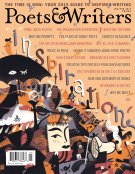Of course it’s the writing that matters, but sometimes it’s out-of-this-world design that brings readers to that writing. “Our mission, in addition to providing a great forum for writing, is to find ways to utilize graphic design so that it illuminates and enhances the reading experience,” wrote Jodee Stanley, the editor of Ninth Letter (ninthletter.com), in 2008. Published jointly by the Graduate Creative Writing Program and the School of Art & Design at the University of Illinois in Urbana-Champaign, the biannual Ninth Letter has been illuminating literature and art for more than a decade. Last year, the Spring/Summer 2014 issue—reminiscent in design of the experimental classic The Medium Is the Massage by media critic Marshall McLuhan and graphic designer Quentin Fiore—exploded off the page in a neon cornucopia of text and image, enhancing breathtaking new nonfiction from Barrett Swanson and social media–infused fiction from Rachel Cantor (“Et tu, @batfly?”). The new Fall /Winter 2014 issue features Ninth Letter’s 2014 Literary Award winners, along with new fiction from Justin Bigos and poetry from Sara Eliza Johnson. Ninth Letter accepts poetry, fiction, and nonfiction submissions online or by mail until February 28; the submission period for the third annual Literary Awards in poetry, fiction, nonfiction, and translation opens March 5.
For longtime readers of Gulf Coast (gulfcoastmag.org), it is apparent that the University of Houston–based journal has, with each issue, slowly and adeptly increased its use of powerful design—influenced recently, no doubt, by its 2013 merger with the art journal Art Lies. But the biannual magazine has hit a high-water mark of sorts with its most recent issue, 27.1, their most visually enchanting installment to date. The issue includes both a mind-warping cover and text collaborations with Houston, Texas–based language arts activist group Antena, an image-saturated profile of the artist collective Otabenga Jones & Associates, and asemic writing by poet David Jalajel scattered throughout the issue. “You’ll see that we’ve amped up our design a bit,” notes new managing editor Martin Rock. Perhaps the journal hasn’t even reached flood stage yet, as Gulf Coast’s forthcoming issue 27.2 will draw inspiration from book arts, with a letterpress cover collaboration with Workhorse Printmakers in the works. The Gulf Coast editors consider poetry, fiction, and nonfiction submissions (with a $2 fee) online and by mail from September 1 through March 1.
“Sometime around 2008,” noted James Yeh in a 2013 interview, “four writers—Lincoln Michel, Rozalia Jovanovic, Ann DeWitt, and I—in New York got together to make a really big literary magazine for really short writing.” So goes the origin story of Gigantic (thegiganticmag.com), a magazine with a name that’s neither fully ironic nor accurate: It’s the opposite of the chiseled bursts of writing Gigantic publishes annually, but spot-on about the feeling one gets reading each issue, where images and text are given equal footing. Issue 6, Gigantic Ha-Ha, comes in an unusual grab-bag format, designed by Erin Grey West, and features similarly off-kilter new fiction from A. D. Jameson, James Hannaham’s artist’s statement from his recent exhibition, an interview with comic artist Gabrielle Bell, and a fold-out poster featuring cartoons from Roz Chast, Michael Crawford, and many others. Gigantic accepts fiction, nonfiction, and art submissions year-round via Submittable.
Wedding form and content, each issue of the new poetry annual Parallax (singingsawpress.com) includes eleven colorful, 11 x 17–inch, image-infused poetry broadsides, each of which combines the work of one artist with one poet. Founded by Norah Maki and Allyson Paty in 2012, Brooklyn, New York–based Parallax has produced two issues featuring the work of poets such as Lucy Ives, Catherine Wagner, and Shane McCrae collaborating with visual artists like Gabriela Vainsencher, Cassie Jones, and Courtney Andujar. “The aim of this work is to foster collaboration and dialogue, both contributor-to-contributor and in a more formal way, between image and text,” notes Paty. The third issue is due out in March. For future issues interested poets and artists can query the editors at singingsawpress@gmail.com.
Travis Kurowski is the editor of Paper Dreams: Writers and Editors on the American Literary Magazine, published in 2013 by Atticus Books. His website is traviskurowski.com.








